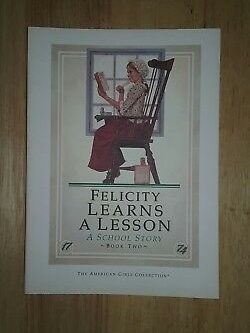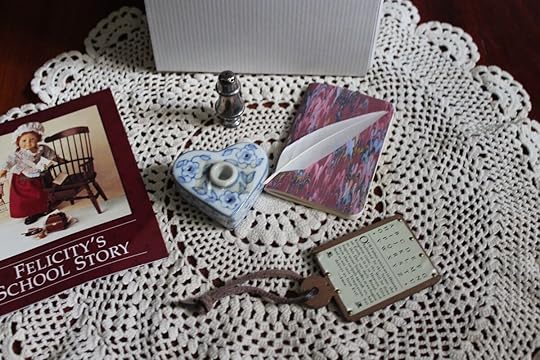The Time Machine: Hornbooks
This is a post straight from the brain archives of Baby Avon. When I was a little kid, I was OBSESSED with the American Girl books, and my second favourite was Felicity Merriman (my first was Samantha Parkington, obviously). If you’re not familiar, the original books were in six-part series, each focusing on a different aspect of a historical girl’s life, and each including a non-fiction afterword discussing real aspects of life, like technology and artefacts, little rhymes, important historical figures, and tradtions. The second book was usually [Girl] Learns A Lesson, which showed how education worked in that particular time period, as well as a life lesson the girl would take on, personally. Felicity (1774) went to ettiquette school, where she learned how to politely decline tea without ruining friendships, and navigate the delicate socio-political landscape in the days leading up to the American Revolution. In the afterword, we were introduced to how boys and girls were educated differently, and what sorts of things they learned. One thing that stuck with me was the hornbook.
~This post contains affiliate links. If you’re interested in any of these items, please consider purchasing through the link provided. It gives me a little bit of Jeff Bezos’ filthy, filthy lucre because writing full time is expensive, and he doesn’t need the money for more joyrides in space.  ~
~

Like we discussed in the post about coffeehouses, this was the Age of the Enlightenment. And what’s fun is that that extended to children, too! The education of chldren has always been important for as long as people have had children- setting up the new generation is so universal as to be probably instinctual. Now, what that looks like differs across eras and cultures, so we’re going to just focus on the Enlightenment.
We all know the printing press was underway by Johannes Gutenberg in 1440, but contrary to popular belief, that did not necessarily herald a boom in widespread literacy like conventional wisdom postulates. The existence of printed media does make dissemination faster and easier, but it does not correlate to a universally literate population. Hell, media is more widespread now than at any point in human history, and the illiteracy rate in the United States is 21%, as of 2022. So obviously, literacy, defined as the ability to read short texts and understand written sentences, is an important skill, and one that has the capacity to grant access to better opportunities. This was just as important in the 1700s, and began much the same way it does today: learning to recognise the shapes of letters.
At its heart, a hornbook is a handheld tablet of wood or metal, with a sheet of paper or vellum with the printed alphabet, numbers, sometimes basic letter combinations, and short verses like the Lord’s Prayer, as an example of how the letters are combined to make words and phrases. These little primers are called abecedaria, which is a word I just now learned, and I’m obsessed with it. On top of this is a thin layer of mica or horn, hence the name, to protect it. It looks like a hand mirror, but with letters printed on it. Sometimes the handle had a hole in it so that the hornbook could be hung from a cord around the child’s waist so they could practice on the go.
 I completely forgot they sold her school supplies, back in the day
I completely forgot they sold her school supplies, back in the dayThey were called hornbooks, but they weren’t really books the way we think of books. they were not bundles of pages, but just the one sheet protected by the horn or mica. You might think that’s pretty limiting, but remember how complex language, especially written language, is. It takes a little while of repitition and memorization to get it. So, they would start with recognising the basic shapes of block printing, then learn the lower case shapes, then numbers, then how they all fit together, then they get to play with how words are made, and how they carry meaning. They would also usually have a tutor or governess who would guide them through how to use the hornbook, and as they progress into learning to write and imitate the shapes in their own hand, and how handwriting differs from print. It looks simple, but it’s actually a complicated little bit of tech that played a huge role in the literacy of a generation that had a lot to say.
Abecedaria are ANCIENT tools that lasted well into the 18th century, so by the time we got to this era, they were already on their way out, yielding to the advent of dedicated children’ literature. I’m playing with a Northanger Abbey sequel that includes an exploration of real-world children’s lit. In fact, the hornbook faded out so slowly that by the time 19th century antiquarians started selling them as antique collectibles, they were shocked by the scarcity. Most of them had been destroyed or misplaced over the years, just over the natural course of time, as things intended for children often were. It wasn’t until like the 1930s that childhood was seen as an important phase in human development. Childhood items were often handed down, repurposed, or simply thrown away when they were no longer needed, people weren’t as sentimental back then as we are now. Case in point, me still yapping nearly 30 years later about a thing I learned in a storybook related to a doll I wanted.
Full circle.



